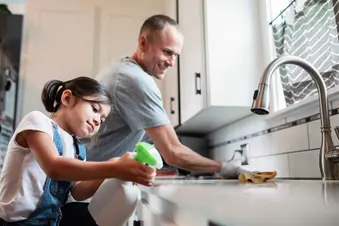
MYTH: Hand Sanitizer Equals Hand-Washing
Alcohol-based hand sanitizers work by killing germs on your hands. When you don’t have access to a sink, hand sanitizer is a better choice than not washing your hands at all. But it can’t kill all types of germs or remove chemicals like pesticides. Hand-washing removes all types of germs from your hands. By lathering up with soap and water and scrubbing your hands for 20 seconds, you’ll destroy germs on your hands. When you rinse, any germs and chemicals will wash down the drain.
MYTH: Dryers Are Cleaner Than Paper Towels
When visiting a public restroom, you can be sure that paper towels are the cleanest choice for drying your hands. Drying your hands with paper towels will keep more germs off your newly clean hands than air dryers. Towels will also dry them faster. Plus, the friction that’s created will free up bacteria to leave your hands that much cleaner.
MYTH: Antibacterial Soap Tops Plain Soap
Every day, millions of people use antibacterial hand soaps and body washes (also called antimicrobial or antiseptic soaps). Antibacterial soaps contain certain chemicals not found in plain soaps. Those ingredients are added to many products to reduce or prevent bacterial infection. But according to the FDA, there’s no data that shows antibacterial soap works better than plain soap and water for preventing illness.
MYTH: Cleaning and Disinfecting Are the Same
The CDC defines cleaning as the process of removing dirt and dust from surfaces, which can also reduce some germs. Cleaning is a must for lowering the overall germ count in your space. But disinfecting kills germs on surfaces by soaking them with chemicals. Both cleaning and disinfecting are crucial for keeping a clean home.
MYTH: Communal Sanitizers Spread Germs
Once you've sanitized your hands, you’ve disinfected them from any germs that could have been on the bottle. In fact, if everyone uses sanitizer in a public place (such as a supermarket entrance), the risk of germs on communal items will be lower and will help keep everyone safer.
MYTH: Disinfect High-Touch Areas Only
Sure, doorknobs, light switches, refrigerator handles, and similar high-touch surfaces should be disinfected daily. But you should regularly disinfect your home’s common areas, too. This includes your bathrooms, dining room, living room, and so on. Reducing germs throughout your home environment will make it a safer place for everyone.
MYTH: Gloves Protect Better Than Washing
To many people’s surprise, it’s safer to frequently wash your hands and not wear gloves. By wearing gloves, you risk moving germs from one surface to another and contaminating your hands when you remove them. Wearing gloves doesn’t replace cleaning your hands.
MYTH: Use Hot Water When Washing Your Hands
According to the CDC, warm and cold water remove the same number of germs from your hands. Water helps create soap lather that removes germs from your skin when you wash your hands. Water itself doesn’t usually kill germs. To kill germs, water would need to be hot enough to scald your hands. Use your preferred water temperature – cold or warm – to wash your hands.
MYTH: Disinfectant Products Work Fast
Many people use disinfectant wipes to kill germs on surfaces. But it’s important to know these products don’t kill germs right away. Simply wiping down a surface won’t destroy the germs on it. Read the product label carefully to find the instruction titled “to disinfect,” which will tell you how many minutes to leave the product on the surface to kill germs.
Show Sources
SOURCES:
CDC: “Hand Sanitizer Facts,” “The Difference Between Cleaning, Sanitizing, & Disinfecting,” “About Handwashing.”
Cleveland Clinic: “The Dirty Truth About Hand Dryers.”
FDA: “Skip the Antibacterial Soap; Use Plain Soap and Water.”
World Health Organization: “Coronavirus disease (COVID-19) advice for the public: Mythbusters.”
Temple Health: “7 Household Cleaning Myths Debunked.”